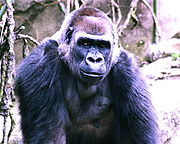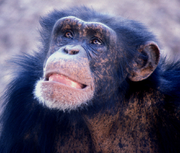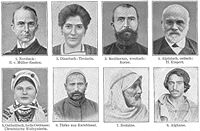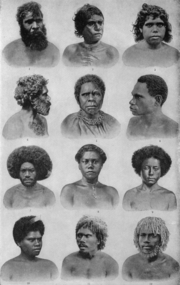
Supraorbital ridge
Encyclopedia
The supraorbital ridge, or brow ridge, refer to a bony ridge located above the eye sockets of all primate
s. In Homo sapiens sapiens (modern humans) the eyebrows are located on their lower margin.
Other terms in use are:

 The size of these ridges varies also between different species of primates, either living or fossil. The closest living relatives of humans, the great apes
The size of these ridges varies also between different species of primates, either living or fossil. The closest living relatives of humans, the great apes
, have relatively pronounced supraorbital ridges, while in modern humans it is relatively reduced. The fossil record indicates that the supraorbital ridge in early homo was reduced as the cranial vault grew and became positioned vertically, above the face.
Some paleoanthropologists
distinguish between torus and ridge. In anatomy, a torus
is a projecting shelf of bone. Fossil hominids, in this theory, have the torus, but modern humans only have the ridge.
s and early hominids because of the tremendous strain put on the cranium by their powerful chewing apparatuses, which is best demonstrated by any of the members of the genus Paranthropus
. The brow ridge was one of the last traits to be lost in the path to modern humans, and only disappeared with the development of the modern pronounced frontal lobe
. This is one of the most salient differences between Homo sapiens and Homo neanderthalensis
.


said Mongoloids are "absent browridges" and he said "such ridges are absent in the skulls of both sexes in Mongoloid peoples." Dr. Marta Mirazon Lahr of the Department of Biological Anthropology at Cambridge University said the "Paleoindian" has "proto-Mongoloid" "morphology" such as "pronounced development of supraorbital ridges" Anthropologist Arnold Henry Savage Landor
described the Ainu
as having deep-set eyes and a large and prominent browridge.
(after age 4) the growth of the orbit would outpace that of the eye. Consequently, he proposed that facial size is the most influential factor in orbital development, with orbital growth being only secondarily affected by size and ocular position.
Weindenreich (1941) and Biegert (1957, 1963) argued that the supraorbital region can best be understood as a product of the orientation of its two components, the face and the neurocranium.
The most composed articulation of the spatial model was presented by Moss and Young (1960), who stated that “the presence… of supraorbital ridges is only the reflection of the spatial relationship between two functionally unrelated cephalic components, the orbit and the brain” (Moss and Young, 1960, p282). They proposed (as first articulated by Biegert in1957) that during infancy the neurocranium extensively overlaps the orbit, a condition that prohibits brow ridge
development. As the splanchocranium grows, however, the orbits begin to advance, thus causing the anterior displacement of the face relative to the brain. Brow ridges then form as a result of this separation.
To put it simply, the Spatial model proposes that supraorbital torus development can be best explained in terms of the disparity between the anterior position of the orbital component relative the neurocranium.
s. His findings indicated that the face acts as a pillar that carries and disperses tension caused by the forces produced during mastication. Russell (1982, 1985) and Oyen et al. (1979a) elaborated on this idea, suggesting that amplified facial projection necessitates the application of enhanced force to the anterior dentition in order to generate the same bite power that individuals with a dorsal deflection of the facial skull exert. In more prognathic individuals, this increased pressure triggers bone deposition to reinforce the brow ridges, until equilibrium is reached.
In their 1979(a) publication, Oyen et al. conducted a cross-section study of Papio anubis in order to ascertain the relationship between palate length, incisor load and Masseter lever efficiency, relative to torus enlargement. Indications found of osteoblastic deposition in the glabella region were used as evidence for supraorbital enlargement. Oyen et al.’s data suggested that more prognathic individuals experienced a decrease in load/lever efficiency. This transmits tension via the frontal process of the maxilla to the supraorbital region, resulting in a contemporary reinforcement of this structure. This was also correlated to periods of tooth eruption.
In a later series of papers, Russell (1985, 1986a, and 1986b) developed aspects of this mode further. Employing an adult Australian sample, she tested the association between brow ridge formation and anterior dental loading, via the craniofacial angle (prosthion-nasion-metopion), maxilla breadth, and discontinuities in food preparation such as those observed between different age groups. Finding strong support for the first two criteria, she concluded that the supraorbital complex is formed as a result of increased tension due to the widening of the maxilla, thought to be positively correlated with the size of the messeter muscle, as well as with the improper orientation of bone in the superior orbital region.
In short, the bio-mechanical model predicts that morphological variation in torus size is the direct product of differential tension caused by mastication, as indicated by an increase in load/lever ratio and broad craniofacial angle (Oyen and Russell, 1984, p. 368-369).
Primate
A primate is a mammal of the order Primates , which contains prosimians and simians. Primates arose from ancestors that lived in the trees of tropical forests; many primate characteristics represent adaptations to life in this challenging three-dimensional environment...
s. In Homo sapiens sapiens (modern humans) the eyebrows are located on their lower margin.
Other terms in use are:
- supraorbital arch
- supraorbital torus
- superciliary ridge
- arcus superciliaris (Latin, meaning "superciliary arch")
- supraorbital margin and the margin of the orbit
Anthropological concept


Great Apes
Great Apes may refer to*Great apes, species in the biological family Hominidae, including humans, chimpanzees, gorillas, and orangutans*Great Apes , a 1997 novel by Will Self...
, have relatively pronounced supraorbital ridges, while in modern humans it is relatively reduced. The fossil record indicates that the supraorbital ridge in early homo was reduced as the cranial vault grew and became positioned vertically, above the face.
Some paleoanthropologists
Paleoanthropology
Paleoanthropology, which combines the disciplines of paleontology and physical anthropology, is the study of ancient humans as found in fossil hominid evidence such as petrifacted bones and footprints.-19th century:...
distinguish between torus and ridge. In anatomy, a torus
Torus (disambiguation)
Torus or tori may refer to:In botany* Torus, a structure of the xylem* a synonym for a sagittal keel, a structure found in craniaIn mathematics:* Torus, a surface* Torus knot* Algebraic torus* Double torus* Umbilic torus...
is a projecting shelf of bone. Fossil hominids, in this theory, have the torus, but modern humans only have the ridge.
Purpose
The brow ridge functions to reinforce the weaker bones of the face in much the same way that the chin of modern humans reinforces their comparatively thin mandibles. This was necessary in pongidPongid
Pongid refers to mammals of the family Pongidae, currently not in taxonomic use*Originally, until the last few years of the 20th century, Pongidae comprised all the extant species in the current family Hominidae, excluding Homo sapiens and sometimes including the family Hylobatidae .*Currently...
s and early hominids because of the tremendous strain put on the cranium by their powerful chewing apparatuses, which is best demonstrated by any of the members of the genus Paranthropus
Paranthropus
The robust australopithecines, members of the extinct hominin genus Paranthropus , were bipedal hominids that probably descended from the gracile australopithecine hominids...
. The brow ridge was one of the last traits to be lost in the path to modern humans, and only disappeared with the development of the modern pronounced frontal lobe
Frontal lobe
The frontal lobe is an area in the brain of humans and other mammals, located at the front of each cerebral hemisphere and positioned anterior to the parietal lobe and superior and anterior to the temporal lobes...
. This is one of the most salient differences between Homo sapiens and Homo neanderthalensis
Neanderthal
The Neanderthal is an extinct member of the Homo genus known from Pleistocene specimens found in Europe and parts of western and central Asia...
.


In modern humans
Forensic anthropologist Caroline Wilkenson said that Australoids have the largest brow ridges "with moderate to large supraorbital arches", Caucasoids have the second largest brow ridges with "moderate supraorbital ridges", Negroids have the third largest brow ridges with an "undulating supraorbital ridge" and Mongoloids are "absent browridges". Anthropologist Ashley MontaguAshley Montagu
Montague Francis Ashley Montagu was a British-American anthropologist and humanist, of Jewish ancestry, who popularized topics such as race and gender and their relation to politics and development...
said Mongoloids are "absent browridges" and he said "such ridges are absent in the skulls of both sexes in Mongoloid peoples." Dr. Marta Mirazon Lahr of the Department of Biological Anthropology at Cambridge University said the "Paleoindian" has "proto-Mongoloid" "morphology" such as "pronounced development of supraorbital ridges" Anthropologist Arnold Henry Savage Landor
Arnold Henry Savage Landor
Arnold Henry Savage Landor was an English painter, explorer, writer and anthropologist, born in Florence. His grandfather was the poet and writer Walter Savage Landor, who himself lived for long periods in Florence....
described the Ainu
Ainu people
The , also called Aynu, Aino , and in historical texts Ezo , are indigenous people or groups in Japan and Russia. Historically they spoke the Ainu language and related varieties and lived in Hokkaidō, the Kuril Islands, and much of Sakhalin...
as having deep-set eyes and a large and prominent browridge.
Spatial model
Much of the groundwork for the spatial model was laid down by Schultz (1940). He was the first to document that at later stages of developmentChild development stages
Child development stages describe theoretical milestones of child development. Many stage models of development have been proposed, used as working concepts and in some cases asserted as nativist theories....
(after age 4) the growth of the orbit would outpace that of the eye. Consequently, he proposed that facial size is the most influential factor in orbital development, with orbital growth being only secondarily affected by size and ocular position.
Weindenreich (1941) and Biegert (1957, 1963) argued that the supraorbital region can best be understood as a product of the orientation of its two components, the face and the neurocranium.
The most composed articulation of the spatial model was presented by Moss and Young (1960), who stated that “the presence… of supraorbital ridges is only the reflection of the spatial relationship between two functionally unrelated cephalic components, the orbit and the brain” (Moss and Young, 1960, p282). They proposed (as first articulated by Biegert in1957) that during infancy the neurocranium extensively overlaps the orbit, a condition that prohibits brow ridge
Supraorbital foramen
The supraorbital foramen is a bony elongated path located above the orbit and under the forehead. The supraorbital foramen lies directly under the eyebrow....
development. As the splanchocranium grows, however, the orbits begin to advance, thus causing the anterior displacement of the face relative to the brain. Brow ridges then form as a result of this separation.
To put it simply, the Spatial model proposes that supraorbital torus development can be best explained in terms of the disparity between the anterior position of the orbital component relative the neurocranium.
Bio-mechanical model
Research done on this model has largely been based on earlier work of Endo (1965, 1966, 1970, and 1973). By applying pressure similar to the type associated with chewing, he carried out an analysis of the structural function of the supraorbital region on dry human and gorilla skullSkull
The skull is a bony structure in the head of many animals that supports the structures of the face and forms a cavity for the brain.The skull is composed of two parts: the cranium and the mandible. A skull without a mandible is only a cranium. Animals that have skulls are called craniates...
s. His findings indicated that the face acts as a pillar that carries and disperses tension caused by the forces produced during mastication. Russell (1982, 1985) and Oyen et al. (1979a) elaborated on this idea, suggesting that amplified facial projection necessitates the application of enhanced force to the anterior dentition in order to generate the same bite power that individuals with a dorsal deflection of the facial skull exert. In more prognathic individuals, this increased pressure triggers bone deposition to reinforce the brow ridges, until equilibrium is reached.
In their 1979(a) publication, Oyen et al. conducted a cross-section study of Papio anubis in order to ascertain the relationship between palate length, incisor load and Masseter lever efficiency, relative to torus enlargement. Indications found of osteoblastic deposition in the glabella region were used as evidence for supraorbital enlargement. Oyen et al.’s data suggested that more prognathic individuals experienced a decrease in load/lever efficiency. This transmits tension via the frontal process of the maxilla to the supraorbital region, resulting in a contemporary reinforcement of this structure. This was also correlated to periods of tooth eruption.
In a later series of papers, Russell (1985, 1986a, and 1986b) developed aspects of this mode further. Employing an adult Australian sample, she tested the association between brow ridge formation and anterior dental loading, via the craniofacial angle (prosthion-nasion-metopion), maxilla breadth, and discontinuities in food preparation such as those observed between different age groups. Finding strong support for the first two criteria, she concluded that the supraorbital complex is formed as a result of increased tension due to the widening of the maxilla, thought to be positively correlated with the size of the messeter muscle, as well as with the improper orientation of bone in the superior orbital region.
In short, the bio-mechanical model predicts that morphological variation in torus size is the direct product of differential tension caused by mastication, as indicated by an increase in load/lever ratio and broad craniofacial angle (Oyen and Russell, 1984, p. 368-369).
External links
- The Frontal Bone, California State University at Chico site.
- ARCUS SUPERCILIARIS, Webster's Online Dictionary.

